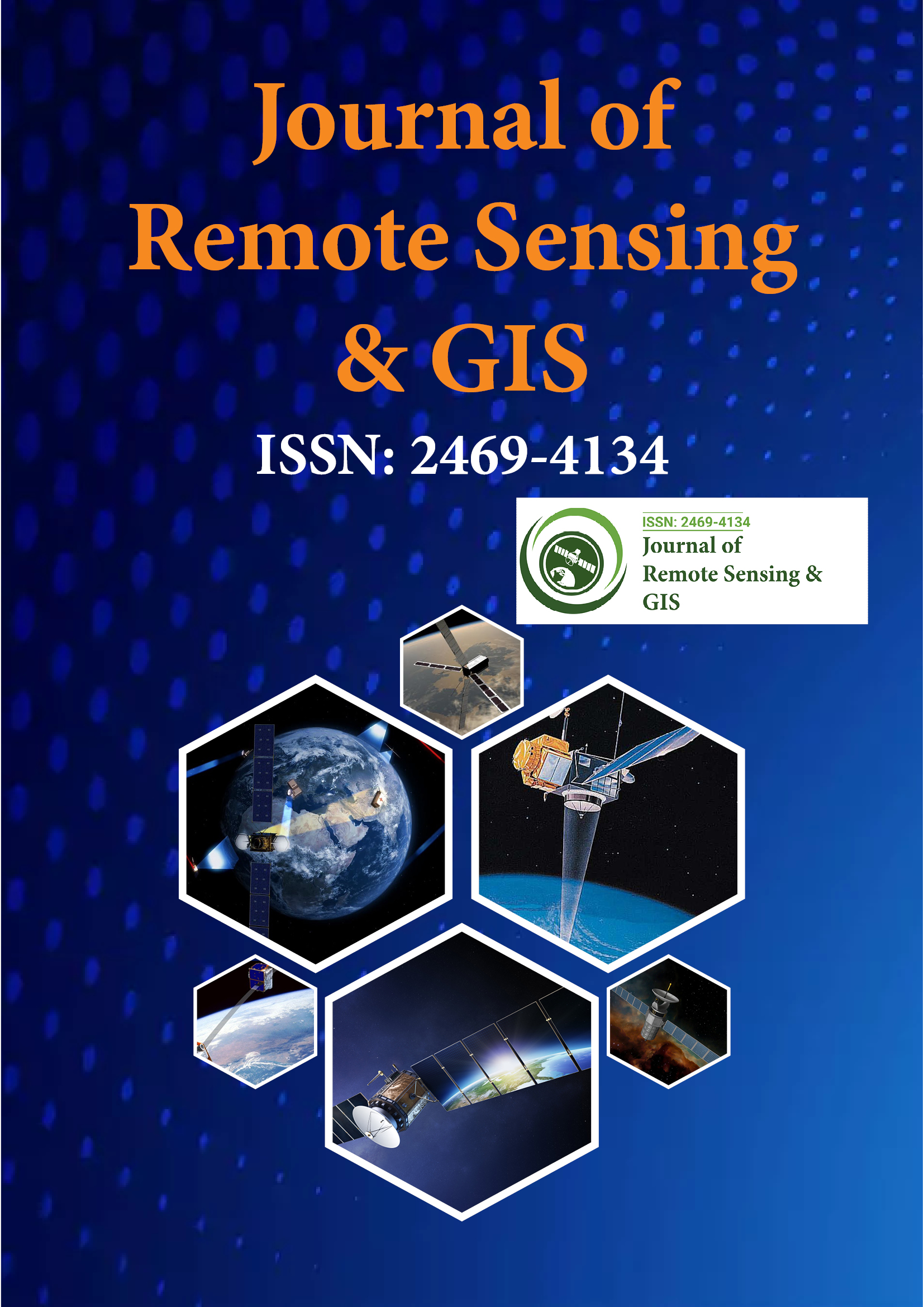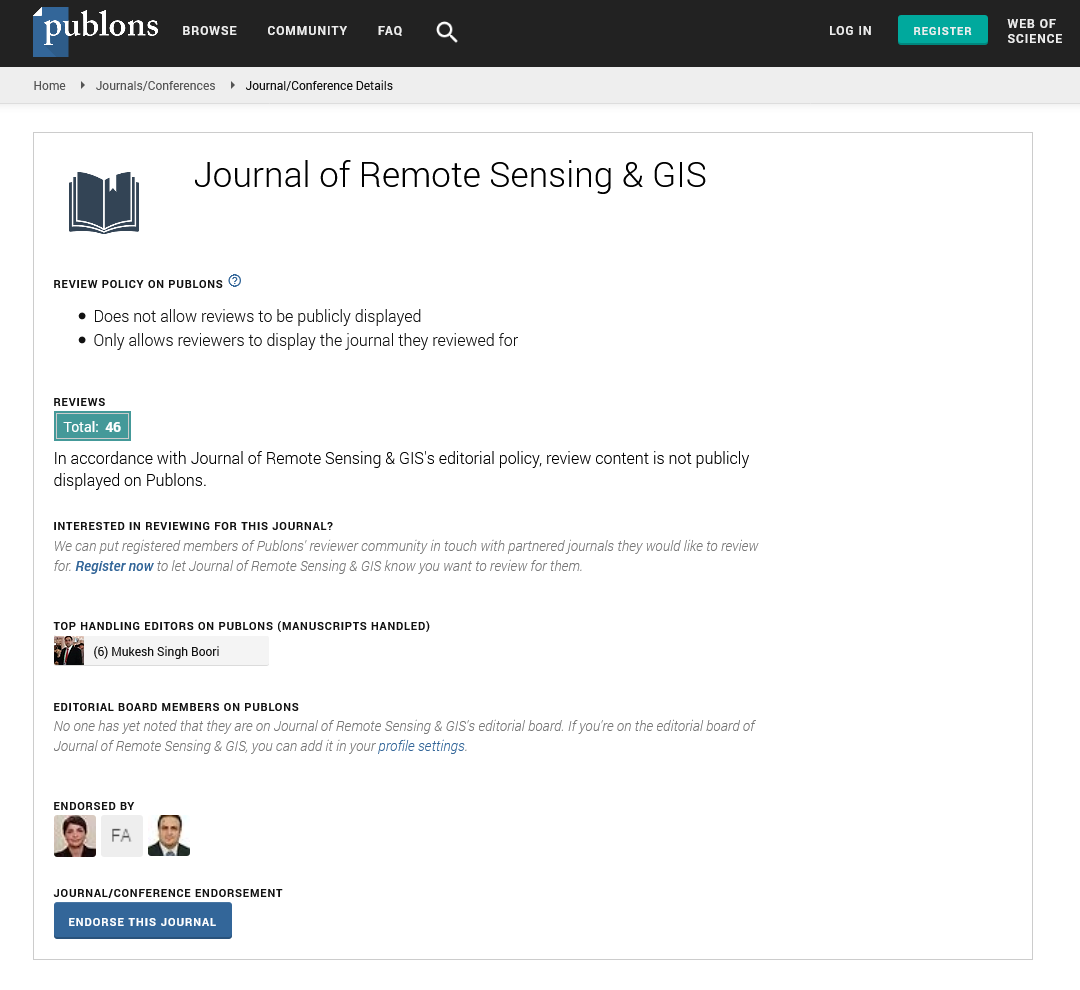Indexed In
- Open J Gate
- RefSeek
- Hamdard University
- EBSCO A-Z
- OCLC- WorldCat
- Publons
- International Scientific Indexing
- Euro Pub
- Google Scholar
Useful Links
Share This Page
Journal Flyer

Open Access Journals
- Agri and Aquaculture
- Biochemistry
- Bioinformatics & Systems Biology
- Business & Management
- Chemistry
- Clinical Sciences
- Engineering
- Food & Nutrition
- General Science
- Genetics & Molecular Biology
- Immunology & Microbiology
- Medical Sciences
- Neuroscience & Psychology
- Nursing & Health Care
- Pharmaceutical Sciences
Opinion Article - (2024) Volume 13, Issue 3
Mitigating Urban Heat Islands Effects with Remote Sensing and GIS-Based Solutions
Min Wang*Received: 26-Aug-2024, Manuscript No. JGRS-24-26974; Editor assigned: 29-Aug-2024, Pre QC No. JGRS-24-26974 (PQ); Reviewed: 13-Sep-2024, QC No. JGRS-24-26974; Revised: 20-Sep-2024, Manuscript No. JGRS-24-26974 (R); Published: 27-Sep-2024, DOI: 10.35248/2469-4134.24.13.356
Description
Urbanization, while driving economic growth and technological advancement, has resulted in numerous environmental challenges, with one of the most pressing being the Urban Heat Island (UHI) effect. UHI refers to the phenomenon where urban areas experience significantly higher temperatures than their surrounding rural counterparts, primarily due to the extensive replacement of natural land cover with impervious surfaces such as roads, buildings and other infrastructure. This temperature disparity can exacerbate health issues, increase energy demand and worsen air quality. The detection and mitigation of UHIs have thus become essential for sustainable urban planning and public health.
Remote sensing and Geographic Information Systems (GIS) have emerged as powerful tools in detecting, analyzing and addressing the UHI effect. These technologies provide important data and insights on land surface temperatures, land use, vegetation cover and other factors influencing urban heat distribution.
Remote sensing for UHI detection
Remote sensing technology, which involves the collection of data from satellite or airborne sensors, plays a pivotal role in detecting UHIs. By capturing spatially explicit data, remote sensing provides a comprehensive view of Land Surface Temperatures (LST) across urban and rural areas. This data is important for identifying hotspots areas where the UHI effect is most pronounced-and for tracking temperature changes over time.
One of the most commonly used sensors for UHI detection is the Moderate Resolution Imaging Spectroradiometer (MODIS) aboard NASA's Terra and Aqua satellites. MODIS provides frequent observations of Earth's surface, including temperature data, which can be used to monitor UHIs globally. Another important dataset comes from the Landsat series of satellites, which offer higher spatial resolution data, making it possible to analyze UHI patterns at a finer scale.
In addition to thermal infrared data, remote sensing also captures information on Land Use and Land Cover (LULC). Vegetation indices, such as the Normalized Difference Vegetation Index (NDVI), derived from optical remote sensing data, are useful for assessing the amount of vegetation in urban areas. Areas with less vegetation tend to experience stronger UHI effects, while green spaces and urban parks help mitigate the intensity of UHIs.
GIS in UHI analysis
GIS is an invaluable tool for analyzing and visualizing spatial data related to UHIs. It enables the integration of multiple datasets, including LST, LULC, population density and socioeconomic data, allowing researchers and urban planners to gain a holistic understanding of the factors contributing to the UHI effect. By overlaying temperature data with urban infrastructure maps, GIS can help identify areas where mitigation strategies, such as increasing green spaces or implementing reflective roofing materials, would be most effective.
One key application of GIS in UHI analysis is the identification of vulnerable populations. By mapping high-temperature areas in relation to population density and demographics, GIS can highlight neighborhoods at greater risk of heat-related illnesses. This information is important for prioritizing UHI mitigation efforts and ensuring that resources are directed to areas with the greatest need.
GIS also supports the development of predictive models for UHI mitigation. By incorporating various spatial datasets, such as building heights, vegetation covers and road networks, GIS can simulate the potential impacts of different mitigation strategies. For example, urban planners can use GIS models to assess how increasing tree canopy coverage or installing green roofs in specific areas might reduce local temperatures.
UHI mitigation strategies
Once UHIs have been detected and analyzed using remote sensing and GIS, the next step is to implement mitigation strategies. Several approaches have proven effective in reducing the UHI effect, many of which focus on increasing the reflectivity and vegetative cover of urban areas includes:
Green infrastructure: One of the most effective ways to mitigate UHIs is through the use of green infrastructure. Urban trees, parks and green roofs provide shade and promote evapotranspiration, which helps cool the surrounding environment. Studies have shown that areas with abundant vegetation experience lower temperatures than densely built-up areas with little or no greenery. Incorporating green infrastructure into urban design not only reduces the UHI effect but also provides additional benefits, such as improving air quality, enhancing biodiversity and promoting mental wellbeing.
Cool roofs and pavements: Cool roofs and pavements are designed to reflect more sunlight and absorb less heat than traditional materials. These surfaces have higher solar reflectance, or albedo, which reduces the amount of heat retained by buildings and roads. By reducing the amount of heat absorbed by urban infrastructure, cool roofs and pavements can significantly lower surface temperatures, thereby reducing the overall intensity of the UHI effect.
Urban planning and design: Strategic urban planning and design also play a important role in mitigating UHIs. Compact urban development, mixed land use and well-designed street networks can minimize the heat retention caused by sprawling, low-density development. Furthermore, orienting buildings to maximize natural ventilation and incorporating water features, such as fountains or ponds, can help cool urban environments.
Conclusion
Remote sensing and GIS technologies offer valuable tools for detecting and mitigating the UHI effect. By providing detailed data on land surface temperatures, land cover and other relevant variables, these technologies enable researchers, policymakers and urban planners to better understand the spatial dynamics of UHIs. Moreover, they facilitate the development of targeted mitigation strategies, such as increasing green infrastructure, implementing cool roofing materials and promoting sustainable urban design. As cities continue to grow, the application of remote sensing and GIS will be essential for creating more resilient and urban environments that can withstand the challenges posed by climate change and rapid urbanization.
By combining these technological approaches with thoughtful urban planning, the detrimental impacts of UHIs can be reduced, improving public health, reducing energy consumption and enhancing the quality of life for urban residents.
Citation: Wang M (2024). Mitigating Urban Heat Island Effects using Remote Sensing and GIS-Based Solutions. J Remote Sens GIS. 13:356.
Copyright: © 2024 Wang M. This is an open-access article distributed under the terms of the Creative Commons Attribution License, which permits unrestricted use, distribution and reproduction in any medium, provided the original author and source are credited.

